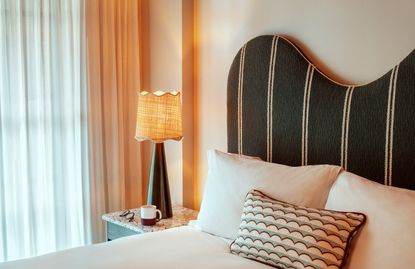‘It tells your brain it’s time for bed!’ - Experts agree this one LED light color will help you sleep better
This particular LED color signals to your brain that it’s time for bed, and helps you produce melatonin to sleep better


If, like me, you're constantly chasing (but not quite catching) the perfect restful night’s sleep, you’ve probably made at least a few changes to your bedroom design. A comfortable mattress and pillows, soft bedsheets, walls painted a calming color, and low-level lighting are all essential - and if you really went to town, you’ve soundproofed the space as much as possible, too. I admit I'm guilty of literally every item on this list, and I've still not mastered the ultimate sleep sanctuary yet. The trick, say experts, could be down to LED lighting.
I had no clue that a detail so seemingly small as LED color could have such a big impact, but sleep experts all agree that there's one particular light color that helps you sleep better, as well as one that does the exact opposite. I thought banning overhead lights and only using side lamps was enough to cross ‘good lighting’ off the list, but what I had wrong all along was the color of my bulbs. I've followed the expert advice and I can honestly say it's really made a difference. Here’s what they recommend for the best night's rest.
What LED light color helps with sleep?
After speaking to the experts I found out that when it comes to bedroom lighting, the color red - or tones of amber - are really effective in facilitating a good night’s rest and telling your brain it's time for bed.
‘A study previously found red light therapy exposure increased melatonin levels – a hormone associated with controlling sleep – and was also effective in boosting the quality of sleep,’ explains Theresa Schnorbach, Sleep Scientist at sleep company Emma. ‘I would suggest using a warmer colored (orange-red) light in the hours before sleep to help aid better rest.'
So, how do you do it? It really is as simple as switching the lightbulbs for the lights you use in the evenings, and you’ll notice the difference in how you feel. These bulbs from Target are just right for the job.
It's not just the color of light that has an impact, but also the intensity, too. Theresa warns that lower-intensity light signals to our brains that it's time to go to bed. ‘This is why we often feel more sleepy in the winter,’ she says. So once you’ve changed the color of your bulbs, also think of putting them on a dimmer, or using the softer glow of a lamp instead of overhead lighting.
‘Opting for an amber shade helps you drift off easier because the warm lighting doesn’t disrupt your circadian rhythm,’ agrees Chris Tattersall, Sleep Expert at Woolroom. 'I would therefore recommend that a few hours before you go to sleep, you switch to a red or amber light, as this will help your body naturally prepare for bedtime.'
Why does light color make a difference to sleep quality?

It might sound obvious but light has a bigger influence on our sleep than you might realize, and it’s all linked to our circadian rhythm. ‘Our circadian rhythms (or body clock) are regulated by a central circuit in the brain that is sensitive to light, called the suprachiasmatic nucleus,’ Theresa explains. ‘This controls the production of hormones that support when we sleep and when we wake.'
Dr. Saya Nagori, expert ophthalmologist and the founder of Eye Facts agrees. ‘Red LED lights, especially when used in bedrooms, have an almost magical propensity to encourage a restful sleep,' she adds. 'By fostering the secretion of melatonin, the sleep hormone, these lights pave the way for a restorative night’s rest.'
What color LED lights should be avoided for sleep?

While red, amber, or warm yellow LED lighting can aid sleep, there are some light colors - whether that's coming from your lighting accessories or electronic devices - that are detrimental. These should be avoided if we’re looking to rest as they will cause our sleep quality to plummet.
‘The high-level blue light emitted from our mobile phones, laptops, televisions, and other electronic devices disrupt our body's production and secretion of melatonin, therefore confusing our natural circadian rhythms, causing us to wake up when nature wants us to sleep and recharge,' explains Chris. 'In short, blue light tells our bodies it is ‘daytime’, meaning it stops producing melatonin – the hormone that makes us sleepy.'
Saya offers a piece of advice for those of us who tend to wake up in the dead of night. ‘Resist the pull of bright white lights,' she says. 'Their sharpness can yank you out of your drowsiness, making it harder to drift back into sleep. Opting for the milder red lights, in this case, is akin to choosing a gentle lullaby over an alarm bell.'
When it comes to waking up, Theresa tells me that the LED light color that greets you first thing in the morning is equally important and, in turn, can help you sleep better at night. ‘As we head into winter and often find ourselves waking up in the dark, you could replicate the feeling of waking up to natural sunlight in the morning through artificial lighting,' she says. 'A previous study actually showed that using sunrise wake-up light 30 minutes before your wake-up time may reduce grogginess upon awakening.'
Creating the right conditions for a restful night's sleep can vary from person to person, however, if science has anything to say about it, it proves that light is definitely an important factor that does make a big difference!

Price: $35
Low level lamps produce a more relaxing atmosphere, especially when the bulb is warm colored.

Price: $13.99 (pack of two)
These amber bulbs will create a very calming light similar to that of a candle.

Price: $103.99 (set of two)
These beautiful lamps with warm yellow bulbs will add to the relaxing atmosphere of your living room or bedroom.
Be The First To Know
The Livingetc newsletter is your shortcut to the now and the next in home design. Subscribe today to receive a stunning free 200-page book of the best homes from around the world.

Raluca is Digital News Writer for Livingetc.com and passionate about all things interior and living beautifully. Coming from a background writing and styling shoots for fashion magazines such as Marie Claire Raluca’s love for design started at a very young age when her family’s favourite weekend activity was moving the furniture around the house ‘for fun’. Always happiest in creative environments in her spare time she loves designing mindful spaces and doing colour consultations. She finds the best inspiration in art, nature, and the way we live, and thinks that a home should serve our mental and emotional wellbeing as well as our lifestyle.
-
 How to Thaw a Frozen Pipe — Learn Everything You Need to Know in 5 Minutes With This Guide
How to Thaw a Frozen Pipe — Learn Everything You Need to Know in 5 Minutes With This GuideWinter storm caught you off guard? We asked an expert — just how do you thaw a frozen pipe?
By Hugh Metcalf Published
-
 The 12 Very Best Silk Bedding Pieces — As Our Style Editor Says: 'It's What Dreams Are Made Of!'
The 12 Very Best Silk Bedding Pieces — As Our Style Editor Says: 'It's What Dreams Are Made Of!'Slumber in lustrous luxury with the very best silk bedding sheets, duvets, pillowcases, and more — your sleep score will thank us later
By Julia Demer Published

